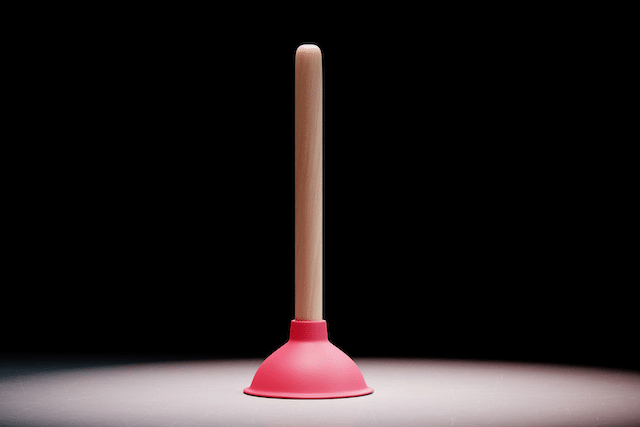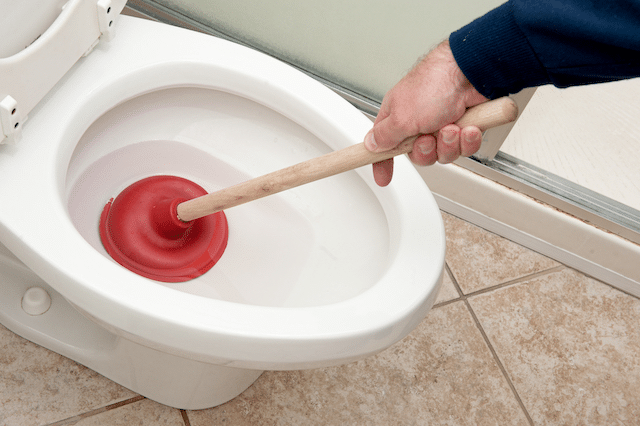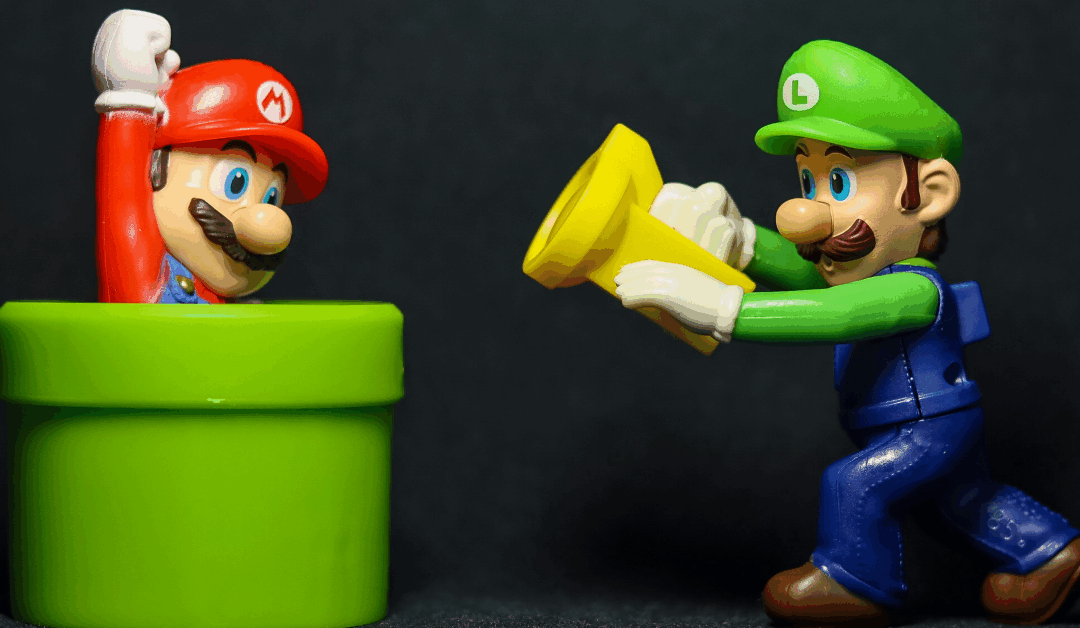Do you know how to unclog a toilet without harming your plumbing and sewer system?
A clogged toilet is one of the most inconvenient household issues—you’re left with standing water, frustration, and a race against time to prevent a messy overflow. Before you reach for your phone to call a plumber and spend unnecessary money, try tackling the problem yourself. With the right tools and techniques, you can often unclog a toilet quickly and efficiently.
This guide provides step-by-step methods to unclog a toilet, from simple tricks using household items to more advanced tools. Don’t worry—it’s easier than it looks, and you might even save yourself some cash by solving it DIY-style.
Schedule Service Online
Get a free estimate so you know what you're signing up for
"*" indicates required fields
For Emergency Services Call: 410-255-9300

Why Toilets Get Clogged
To effectively approach the unclogging process, it’s helpful to understand why clogs happen in the first place. Here are some common reasons:
Common Reasons Why Toilets Get Clogged
Understanding the root cause of a toilet clog is essential for preventing it in the future. Here are some of the most common reasons your toilet might get clogged:
Flushing Non-Flushable Items
One of the main reasons toilets get clogged is flushing items that aren’t meant to go down the drain. Wet wipes, even the ones labeled “flushable,” feminine hygiene products, paper towels, and dental floss can stick together or get caught in the narrow pipes, leading to blockages.
Excessive Toilet Paper Use
While toilet paper is designed to break down in water, using too much at once can create clumps that fail to move smoothly through the plumbing system. This is especially problematic in older systems with narrower pipes.
Low-Flow Toilets
Low-flow toilets, particularly older models from the 1990s during the first wave of water-saving designs, may not have enough flushing power to flush waste and paper effectively, leading to frequent clogs.
Blocked Toilet Trap
The S-shaped trap within the toilet is designed to hold water and prevent sewer gases from entering your home. However, it’s also a common place where clogs occur, especially when items like toys, hair, or other debris are accidentally flushed.
Issues with the Sewer Line
Sometimes, the problem doesn’t lie within the toilet itself but rather in the sewer line. Tree roots, broken pipes, or an excessive build-up of debris in the sewer line can obstruct the flow of waste, causing the toilet to back up.
Hard Water Build-Up
If your home has hard water, mineral deposits may accumulate in the toilet’s drains and pipes over time. These deposits narrow the pipes, making it harder for waste to pass through and increasing the risk of clogs.
Faulty Plumbing or Installation
Improperly installed toilets or pipes with poor alignment can cause frequent clogs. If the pipes are too narrow or aren’t at the correct slope, waste may not flow properly, leading to blockages.
By understanding these common causes, you can take proactive measures to prevent clogs in your toilet. Simple habits like only flushing toilet paper and ensuring regular plumbing maintenance can go a long way in maintaining a clog-free bathroom.
Now that we understand the problem let’s jump into the most effective steps to address it.
Method 1: The Basic Plunge
The plunger is a classic and reliable tool for resolving most toilet blockages.
Steps:
- Check for Enough Standing Water: Make sure there’s enough water in the toilet bowl to cover the rubber part of the plunger. If it’s too low, carefully pour warm water into the bowl from a bucket.
- Create a Good Seal: Position the plunger over the drain hole, ensuring an airtight seal. The cup of the plunger should completely cover the hole to maximize pressure.
- Plunge with Force: Hold the plunger with both hands and push down firmly, then pull back. Repeat this step about 10-15 times or until the water starts to drain.
- Check the Drain: Once the clog is dislodged, flush the toilet. Watch carefully to ensure the water flows normally.
Tip:
For stubborn clogs, try using a flange plunger, which is specifically designed for toilets and can provide more pressure than a traditional cup-style plunger.
Method 2: Hot Water and Dish Soap
When you don’t have a plunger handy, you can unclog a toilet with items you probably already have in your home.
Steps:
- Add Dish Soap: Pour about ½ cup of dish soap directly into the toilet bowl. The soap will help dissolve grease and break down the clog.
- Carefully Pour Hot Water: Heat water until it’s hot but not boiling (water that’s too hot can crack your toilet bowl). Carefully pour the water from waist height into the bowl to create pressure that may dislodge the clog.
- Wait and Flush: Allow the mixture to sit for about 15-20 minutes, then flush the toilet. If the water drains slowly, repeat the steps until the clog is cleared.
Note:
Never use boiling water, as it may damage the porcelain of the toilet.
Method 3: Baking Soda and Vinegar
This natural solution is ideal for breaking down blockages caused by organic matter.
Steps:
- Combine Ingredients: Pour 1 cup of baking soda into the toilet bowl, followed by 2 cups of vinegar.
- Wait and Watch: Allow the bubbling reaction to work its magic. This chemical reaction can help dissolve and loosen the clog.
- Add Warm Water: After 10-15 minutes, pour warm (not boiling) water into the bowl.
- Flush: Check if the water drains properly. If not, repeat the steps.
Method 4: Use a Wire Coat Hanger (For Stubborn Clogs)
If the above methods don’t work, it’s time to bring out simple tools, such as a wire coat hanger.
Steps:
- Prepare the Hanger: Straighten a wire coat hanger, leaving a small hook on one end. Wrap the hook in a plastic bag for a softer edge to prevent scratching the toilet bowl.
- Access the Clog: Gently push the hanger into the drain to access the blockage.
- Dislodge the Clog: Carefully maneuver the wire around to break up or pull out the clog.
- Flush and Clean: Once the water starts draining, flush the toilet. Wipe down the hanger before properly disposing of it.
Method 5: Use a Toilet Auger or Plumber’s Snake
For severe clogs that can’t be cleared with plunging or home remedies, a toilet auger or plumber’s snake can reach much deeper into the toilet trap.
Steps:
- Insert the Auger: Follow the manufacturer’s instructions carefully to insert the auger into the toilet bowl.
- Crank and Push: Use the crank to extend the auger into the toilet’s drain, breaking apart or hooking onto the clog.
- Pull Out the Clog: Carefully pull out the auger and any debris.
- Flush the Toilet: Test the drain with a gentle flush. You may need to repeat this process for larger blockages.
Preventing Future Clogs
While it’s great to know how to unclog a toilet when disaster strikes, prevention is always the best policy. Here are a few tips:
- Avoid flushing non-flushable items like wipes, tissues, or hygiene products.
- Use only the recommended amount of toilet paper.
- Perform routine maintenance by periodically flushing a mixture of baking soda and vinegar to keep drains clear.
- Invest in high-quality plumbing tools, such as a good plunger and a toilet auger, for emergencies.
Top Products and Brands for Safely Unclogging Toilets
When it comes to unclogging toilets, using the right products can make all the difference. Here are six top-rated products and brands known for their effectiveness and safety, complete with links to purchase:
- Green Gobbler Drain Clog Dissolver: Known for being environmentally friendly while powerful, this clog dissolver works effectively on hair, grease, and toilet paper. Buy Green Gobbler Drain Clog Dissolver
- Drano Max Gel Clog Remover: A trusted name in plumbing, Drano Max Gel cuts through tough clogs fast and is safe for most pipes. Buy Drano Max Gel Clog Remover
- ToiletShroom Revolutionary Plunger: This innovative plunger is designed specifically for toilets, offering a simple, mess-free way to clear blockages. Buy ToiletShroom Revolutionary Plunger
- RIDGID Power Spin Drain Cleaner: Ideal for severe clogs, this manual auger snakes through tough blockages without damaging pipes. Buy RIDGID Power Spin Drain Cleaner
- Liquid-Plumr Full Clog Destroyer Combining power and safety, this product works quickly to clear toilet clogs while being gentle on septic systems. Buy Liquid-Plumr Full Clog Destroyer
- Kleen Freak Antibacterial Plunger: A durable plunger with antibacterial properties, it not only clears clogs but also helps maintain hygiene. Buy Kleen Freak Antibacterial Plunger
These products, paired with proper usage, can effectively help you maintain a clog-free toilet while protecting your plumbing system.
When to Call a Professional Plumber
If you’ve tried all the DIY methods above and your toilet is still clogged, the issue might be deeper within your plumbing system. Calling a licensed plumber at this point will save you time, money, and a potential mess.
Why Call MD Sewer and Plumbing?
When dealing with a stubborn toilet clog or any other plumbing issue, calling the professionals at MD Sewer and Plumbing is the smart choice. Their experienced technicians are equipped with the latest tools and techniques to quickly diagnose and resolve even the most challenging blockages. Beyond unclogging toilets, MD Sewer and Plumbing offers a wide range of services, including sewer line repairs, drain cleaning, pipe installations, and routine plumbing maintenance. With their commitment to prompt service, transparent pricing, and long-lasting solutions, you can trust MD Sewer and Plumbing to keep your home’s plumbing system running smoothly. Don’t wait for minor issues to turn into costly repairs—reach out to MD Sewer and Plumbing for reliable and efficient service today!
Say Goodbye to Clogs
Unclogging a toilet doesn’t have to be an intimidating task. By following these simple methods and using common household items, you’ll handle the challenge with ease. Whether it’s a plunger, dish soap, or a trusty wire hanger, the right approach can save you the headache—and cost—of calling in a professional every time.
Next time you face a clogged toilet, you’ll know what to do. And remember, keeping basic plumbing tools on hand can make all the difference when you need fast results.




